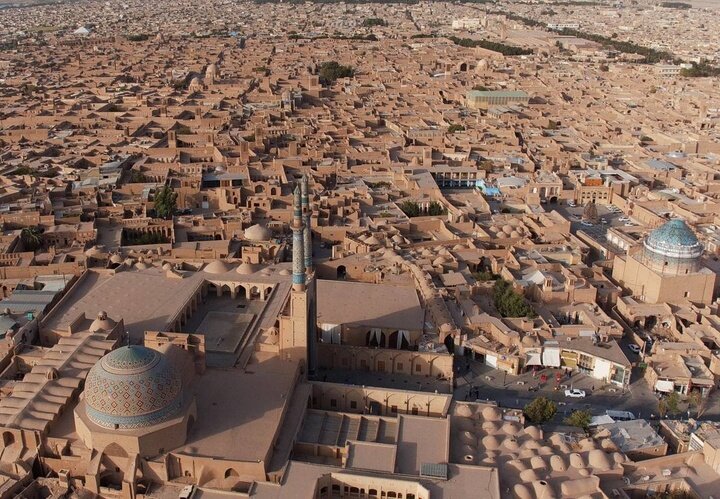Inclusive plan devised to safeguard Yazd’s historical heritage

TEHRAN – In an effort to preserve and protect the historical core of Yazd, registered as a UNESCO World Heritage, a comprehensive monitoring plan has been devised to ensure the conservation of its cultural heritage elements, especially during the influx of New Persian Year.
On Wednesday, Majid Oloumi, who presides over a local office dedicated to World Heritage, revealed that a monitoring and damage assessment strategy for the city’s historical circuit has been meticulously developed.
This initiative, undertaken in collaboration with Yazd’s department for cultural heritage , involves the participation of various local museums and historical sites.
Elsewhere in his remarks, Oloumi underlined the significance of Yazd’s historical fabric, stating that it encapsulates a living museum with rich historical, cultural, and social components.
“The city's historical core is renowned as one of the largest and richest living museums globally, attracting countless domestic and international tourists.”
The official explained that exploring this ancient fabric allows visitors to delve into the cultural tapestry of Yazd, unraveling the origins of historical figures, cultural facets, and various aspects of its venerable civilization.
“Tourism presents both economic and cultural opportunities for cities. Without proper planning, however, this opportunity can turn into a crisis for local communities,” warned Oloumi, underscoring the importance of strategic planning for the city's urban areas.
According to Oloumi, the monitoring plan adheres to the principles outlined in the 1999 International Cultural Tourism Charter.
He explained that this charter promotes two key concepts: the comprehensive protection of historical fabric, allowing the place's credibility to be accessible to visitors and the host community through effective management. The second concept emphasizes collaboration between the preservation community and the tourism industry, provided both entities mutually respect and acknowledge the vulnerability of the targeted heritage.
Throughout the development of the plan, every aspect of the historical fabric, including infrastructural, service-related, heritage, cultural, and scenic elements, has been scrutinized. For each identified need, proposals have been put forth, outlining the specific agencies responsible for addressing them.
Oloumi clarified that the scope of this initiative extends beyond the designated tourist zone, encompassing the entire 660 hectares of the historical fabric.
“The objective is to strategize tourism planning for the entirety of Yazd's historical area, fostering a sustainable and enriching experience for tourists while contributing to the prosperity of the city's historical legacy.”
A “don't miss” destination
With its atmospheric bazaars, winding lanes, a forest of badgirs, mud-brick houses, and delightful places to stay, Yazd is a “don't miss” destination.
Heritage experts believe that Yazd is a living testament to the intelligent use of the limited resources available in the desert for survival. Water is brought to the city through the ancient qanat system.
Each district of the city is built on a qanat and has a communal center. In addition, the use of earth in buildings includes walls and roofs through the construction of vaults and domes. Homes are built with underground courtyards that serve underground areas. Wind catchers, inner courtyards, and thick earth walls ensure a pleasant microclimate.
The man-made underground qanat system is based on snow-fed streams that flow down the foothills of the surrounding mountains. Yazd's earliest water supply is estimated to date from the Sassanid period (224 CE to 651). However, many others have been continuously repaired and used over time, and most surviving ab-anbars (traditional mud-brick cisterns) today can be dated to the late Safavid and Qajar periods.
A top destination, the Yazd Water Museum, is a must-see for anyone wanting to learn more about the brave men who built such underground aqueducts in the past. Housed in a restored manor house with a visible qanat running underneath, the museum offers visitors a fascinating insight into the hidden world of the qanats through a series of photographs, exhibitions, and architectural drawings. It represents almost 2000 years of unique irrigation structure that was in operation but also describes the drilling of mother wells and associated underground water networks that extended to the ancient city.
“The city of Yazd is located in the deserts of Iran close to the Spice and Silk Roads. It is a living testimony to intelligent use of limited available resources in the desert for survival,” the UN body wrote on its website.
“Partially covered alleyways together with streets, public squares, and courtyards contribute to a pleasant urban quality. The city escaped the modernization trends that destroyed many traditional earthen cities.”
From a divine point of view, the city enjoys the peaceful coexistence of three religions: Islam, Judaism, and Zoroastrianism.
AFM
Leave a Comment